While I’ve never carried a boathook aboard any of my boats, it’s not because I wouldn’t find one useful. Where space is limited, boathooks—even telescoping ones—are awkward to stow, so I learned to get by without one. For instance, I always approach a dock on its upwind side so I won’t drift away from it; when I can’t sail within arm’s reach to grab something from the water, I’ll make another pass; to push off a rocky beach I’ll use an oar.
The Revolve Rollable Boat Hook solves the stowing problem by using a concept you’ve seen in the common measuring tape: the steel tape curves across its width to make itself rigid and yet can curl up along its length. The 6′ Revolve does the same thing with a 4″-wide strip of what its manufacturer, Rolatube, calls “bistable rollable composite.” It appears to be made of a fabric infused with black plastic.
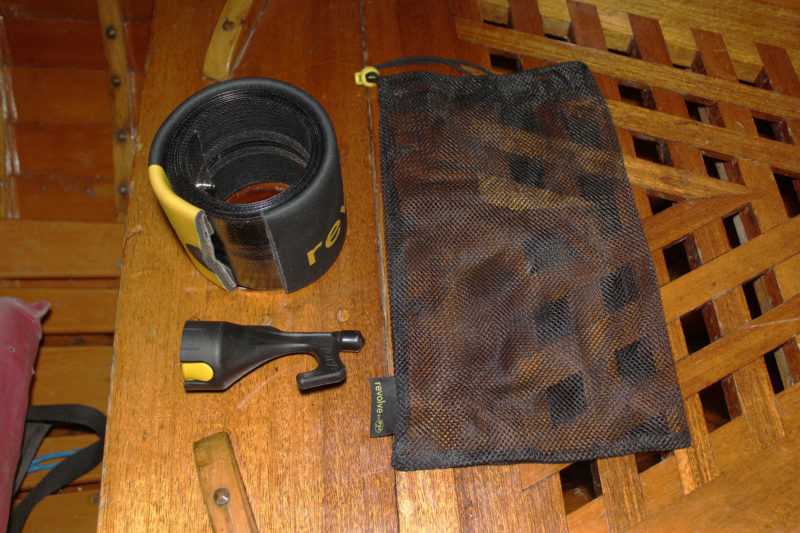 Photographs by the author
Photographs by the authorFor storage, the detachable hook stows inside the rolled-up shaft and the two pieces are kept together in a mesh bag.
Rolled up, the Revolve is about the size of a coffee mug in a thick neoprene cozy. The detachable hook fits inside the rolled shaft, and then the two pieces are stowed together in a mesh bag to keep them from straying from each other when the boathook is not in use. The whole package weighs just a shade under 1 lb.
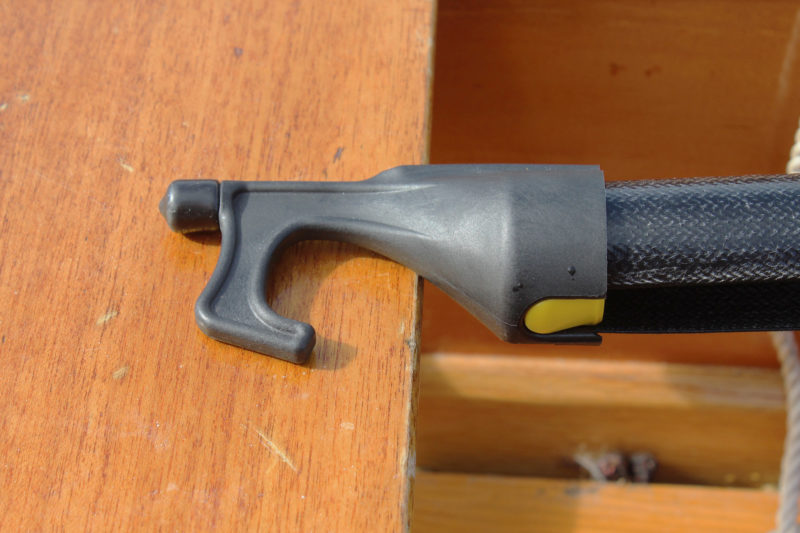
The yellow button unlocks the hook for removal. The dark area to the right of the button is the open side of the shaft.
When the boathook is unrolled for use, the edges curl toward each other to make the better part of a cylinder, leaving a 3⁄4″ open slot between them. The hook slips over the end and locks in place with a twist. Pressing the yellow button unlatches it for removal.
You can extend the Revolve by hand, but for a touch of panache try flinging it out as if briskly drawing a sword and it will uncurl by itself to its full 6′ length (it helps to squeeze the grip end tightly). Rolling the Revolve up again can’t be done with a snap like that, but you can curl the end and then push it into some corner and have it spin while you push the shaft into the roll.
The foam grip gives the Revolve the buoyancy it needs to float, and like a proper boathook, it floats vertically. Only a couple of inches rise above the water’s surface, but that part is bright yellow to make it visible.
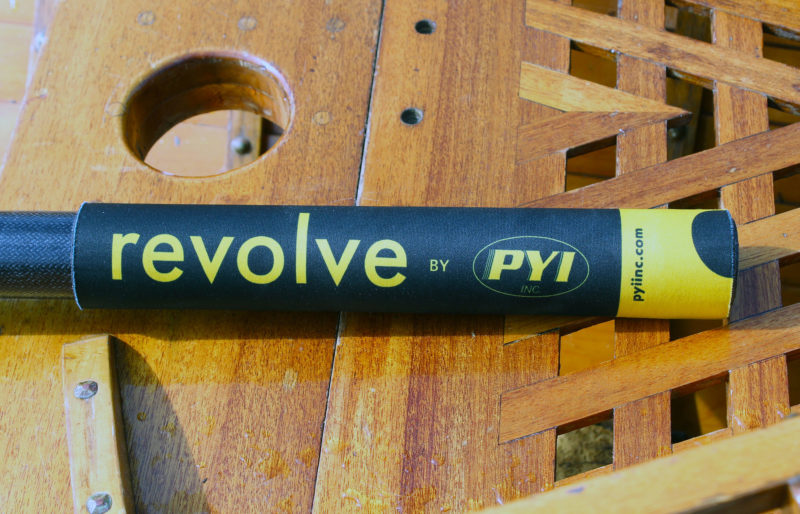
The handle is well padded for a comfortable non-slip grip.
I was concerned about the Revolve’s strength when I first unrolled it. It twisted easily and didn’t feel very strong, but the torsion wasn’t a good measure of how well it would work for pushing and pulling. I set the boathook against a bathroom scale and with both hands on the grip, pushed as hard as I could. The scale registered 100 lbs and the Revolve showed no sign of buckling. Standing to one side and with the hook on a hanging scale, I could pull 90 lbs before beginning to lose my footing. I didn’t expect the Revolve to buckle under tension, but I was pleased that the hook end didn’t break and pull off. Boathooks aren’t always used for pushing or pulling but sometimes are used for prying, with one hand on the top end and the other closer to the middle. The force applied to the hook end is at a right angle to it, not in line with it. I could press against the Revolve sideways against the scale with 80 lbs of pressure. The shaft bowed but didn’t buckle when its open side was facing the scale. With the open side facing the opposite direction, it doesn’t take much force to buckle the shaft. In all my tests with scales, I applied more force than I could imagine needing for a boathook’s intended use.
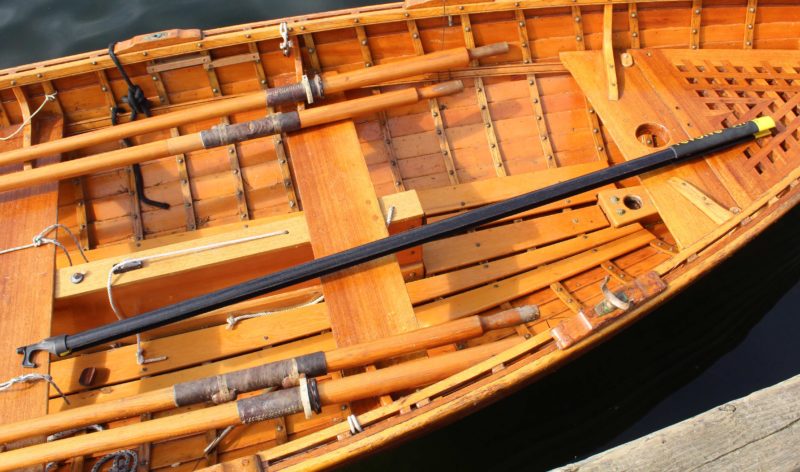
If it weren’t able to roll up into a small package, the 6′ Revolve would be awkward to stow in a 14′ boat.
In use aboard a boat, the Revolve has served well. I don’t have to be so precise pulling up to a dock as long as there’s a cleat to snag with the hook. And in a recent outing I was able to save my Whitehall from taking a beating on a rocky beach by using the Revolve to get the bow into the waves and shove off.
There are three accessories available that can be used instead of the hook end: hard and soft deck brushes, and a universal mount that has a 1⁄4″ x 20 screw compatible with most camera-mount systems. I may spring for the mount so I can use the boathook as a selfie stick. The only issue I can imagine having with the Revolve is remembering where onboard I might have stowed it. Rolled up, it could be in the tiniest, and most out-of-the way-places.![]()
Christopher Cunningham is the editor of Small Boats.
The Revolve Rollable Boat Hook is made by Revolve, a Rolotube Group company in the U.K., and is listed at £84.95. In the U.S. it is distributed by PYI at a list price of $119. I purchased mine on Revolve’s Amazon website for $105.
Is there a product that might be useful for boatbuilding, cruising, or shore-side camping that you’d like us to review? Please email your suggestions.






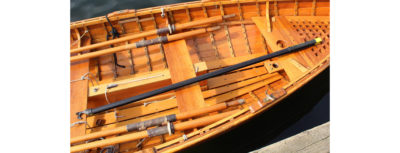


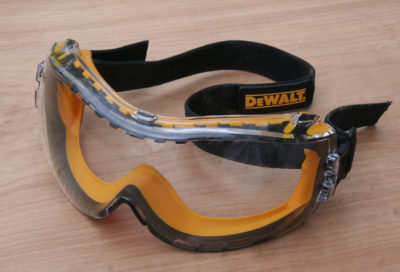
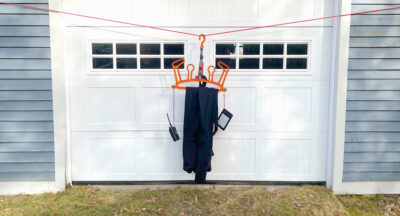
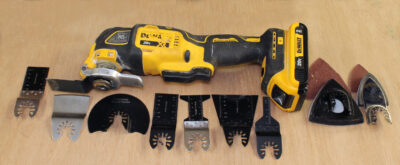
That is the dumbest idea I can think of. Lots of times when you need a boat hook you need it right now!
There are indeed times when you need a boat hook quickly, but most of the time you can anticipate wanting to use it. From picking up the bag to having the Revolve ready to use takes me as little as 13 seconds. If I had a full-length 6’ boathook at the ready in my 14’ skiff, it would be in the way most of the time. I could stow it alongside the centerboard trunk, about the only place it would fit without taking up too much of the space I need while sailing, but it could take me more than 13 seconds to get it out so I could use it, especially if I had any gear on top of it or had it secured in some way to keep it from getting underfoot. The Revolve may not be for everyone, but it works well for me.
Locating the release button for the head of the boat hook where it is located would allow a “missed attempt” to depress the release and allow the removable hook to drop to the bottom of the sea. Locating the release button on the opposite side (the upper side) of the hook assembly would prevent inadvertent release when attempting to use the hook!
To get to the release button, something would have to be ½” wide to get into the recess the button is set in. I clamped a ¼” steel rod in a vice and tried to get it to press the button. The plastic is slippery and it was very difficult to get the button to stay on the rod, impossible to apply any pressure. Even if I were to get the button depressed, removing the hook requires a twist. That’s possible with two hands, one to hold the shaft and press the button, the other to twist the hook. But holding the boat hook’s handle, the slightest twist rolls the hook off the pin. It’s safe to say it would be impossible to have the hook accidentally come off.
Christopher Cunningham
It is a delight to read a positive review where the reviewer has thoroughly tested the product.
Thank you.
I watched the attached video. Pretty slick and compact. Kind of expensive.
Pretty cool hardware.
Where I boat, small-boat docks float. I find I can use an oar or paddle as a “hook” by sticking the blade under a cleat or into a gap in the structure of the floating dock. Twisting it lightly will grip enough to bring the boat alongside. I have yet to break an oar or paddle this way, but I’m careful with the expensive ones.
Thanks for the review.
Thanks for the review.
I just got mine and it is awesome, ingenious. Where I boat and live a boat hook is required by law, so it is nice to have this smart little thing aboard. If I anticipate needing it, I simply unroll and have it ready – otherwise it is stowed out of the way. It works perfectly.